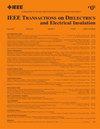Investigation of Moisture Accumulation Induced by Thermal-Fluid Interaction in the High-Voltage Lead Exit of a 750 kV Transformer
IF 3.1
3区 工程技术
Q2 ENGINEERING, ELECTRICAL & ELECTRONIC
IEEE Transactions on Dielectrics and Electrical Insulation
Pub Date : 2025-01-28
DOI:10.1109/TDEI.2025.3535860
引用次数: 0
Abstract
As key components of power systems, transformers are significantly affected by moisture migration in their insulation, impacting performance and reliability. This study combines numerical simulations and experiments to investigate moisture migration in the insulating oil of a 750 kV transformer high-voltage lead exit and its interaction with the thermal flow field. The results indicate that as the operational load and ambient temperature increase, the temperatures of the lead exit and bushing rise, with the hotspot concentrated at the base of the bushing’s capacitor core. However, the small contact area and high thermal resistance between the bushing and the lead exit minimize the impact of the bushing’s temperature rise on the lead exit. The lead exit remains cool, with a slow oil flow, though the temperature gradually increases along the axial direction. Influenced by the local structure and thermal convection, two adjacent, oppositely directed closed oil flow loops form at the lower end of the lead exit and the elevated seat base. Further research finds that under high temperature and high flow conditions, moisture diffuses effectively in the lead exit, but a higher initial moisture concentration inhibits this process. Consequently, moisture accumulates in the low-temperature area of the lead exit’s lower section and the low-flow region at the elevated seat base. When conditions for free water formation exist, free water forms in these regions, and this effect intensifies with higher initial moisture, decreased load, and lower ambient temperature. This study provides theoretical support for optimizing the design and operation of transformer lead exits, improving long-term reliability.750kv变压器高压引线出口热流相互作用致湿积的研究
变压器作为电力系统的关键部件,其绝缘中的水分迁移对其性能和可靠性的影响很大。采用数值模拟与实验相结合的方法,研究了750kv变压器高压引线出口绝缘油中的水分迁移及其与热流场的相互作用。结果表明:随着工作负荷和环境温度的升高,引线出口和衬套温度升高,热点集中在衬套电容铁芯底部;然而,衬套和引线出口之间的小接触面积和高热阻使衬套的温升对引线出口的影响最小化。铅出口保持低温,油流缓慢,但沿轴向温度逐渐升高。受局部结构和热对流的影响,在先导出口下端和高架阀座底座处形成两个相邻的、方向相反的封闭油流回路。进一步研究发现,在高温大流量条件下,水分在引线出口有效扩散,但较高的初始水分浓度会抑制这一过程。因此,水分在先导出口下部的低温区域和高架阀座底部的低流量区域积累。当自由水形成的条件存在时,这些区域就会形成自由水,并且随着初始水分的增加、负荷的减少和环境温度的降低,这种影响会加剧。该研究为优化变压器引线出口设计和运行,提高长期可靠性提供了理论支持。
本文章由计算机程序翻译,如有差异,请以英文原文为准。
求助全文
约1分钟内获得全文
求助全文
来源期刊
CiteScore
6.00
自引率
22.60%
发文量
309
审稿时长
5.2 months
期刊介绍:
Topics that are concerned with dielectric phenomena and measurements, with development and characterization of gaseous, vacuum, liquid and solid electrical insulating materials and systems; and with utilization of these materials in circuits and systems under condition of use.

 求助内容:
求助内容: 应助结果提醒方式:
应助结果提醒方式:


